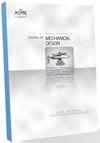A conformal design approach of TPMS-based porous microchannels with freeform boundaries
IF 3
3区 工程技术
Q2 ENGINEERING, MECHANICAL
引用次数: 0
Abstract
Triply period minimal surface (TPMS) based porous microchannels with freeform surfaces are extensively used in various applications, e.g., bone scaffold design and thermal management. However, TPMS-based porous microchannels designed by most existing solutions are difficult to conform with the boundaries of freeform surfaces, and the integrity of the TPMS unit at the surface boundary is easily destroyed. Therefore, this work proposes a conformal design method for TPMS-based microchannels based on mesh surface conformal parameterization. A novel geometric structure, namely “quasi-quadrilateral”, is presented with this approach to control the size and shape of TPMS unit. Then, a design method of TPMS network topology in the 2D parametric domain of mesh surfaces is proposed to determine the positions of TPMS units. Based on this network topology, an algorithm to generate conformal TPMS units and TPMS-based microchannels is further presented. The result microchannels can automatically adapt to various freeform surfaces, and the quality of TPMS unit is greatly improved. Moreover, the effectiveness and practicability of the proposed approach are validated by comparative experiments studies with existing solutions.基于tpms的自由边界多孔微通道的保形设计方法
基于三周期最小表面(TPMS)的多孔微通道具有自由曲面,广泛用于各种应用,例如骨支架设计和热管理。然而,大多数现有方案设计的基于TPMS的多孔微通道难以符合自由曲面的边界,容易破坏TPMS单元在表面边界处的完整性。因此,本文提出了一种基于网格表面保形参数化的tpms微通道保形设计方法。提出了一种新的几何结构,即“准四边形”,以控制TPMS单元的尺寸和形状。在此基础上,提出了一种二维网格曲面参数域的TPMS网络拓扑设计方法,以确定TPMS单元的位置。在此基础上,进一步提出了一种生成共形TPMS单元和基于TPMS的微通道的算法。结果表明,微通道可以自动适应各种自由曲面,大大提高了TPMS单元的质量。通过与已有解决方案的对比实验,验证了该方法的有效性和实用性。
本文章由计算机程序翻译,如有差异,请以英文原文为准。
求助全文
约1分钟内获得全文
求助全文
来源期刊

Journal of Mechanical Design
工程技术-工程:机械
CiteScore
8.00
自引率
18.20%
发文量
139
审稿时长
3.9 months
期刊介绍:
The Journal of Mechanical Design (JMD) serves the broad design community as the venue for scholarly, archival research in all aspects of the design activity with emphasis on design synthesis. JMD has traditionally served the ASME Design Engineering Division and its technical committees, but it welcomes contributions from all areas of design with emphasis on synthesis. JMD communicates original contributions, primarily in the form of research articles of considerable depth, but also technical briefs, design innovation papers, book reviews, and editorials.
Scope: The Journal of Mechanical Design (JMD) serves the broad design community as the venue for scholarly, archival research in all aspects of the design activity with emphasis on design synthesis. JMD has traditionally served the ASME Design Engineering Division and its technical committees, but it welcomes contributions from all areas of design with emphasis on synthesis. JMD communicates original contributions, primarily in the form of research articles of considerable depth, but also technical briefs, design innovation papers, book reviews, and editorials.
 求助内容:
求助内容: 应助结果提醒方式:
应助结果提醒方式:


